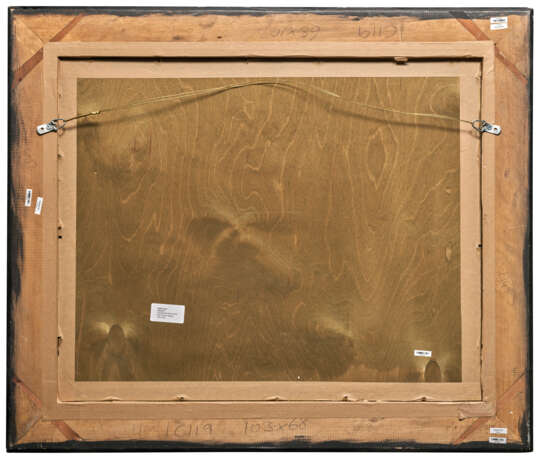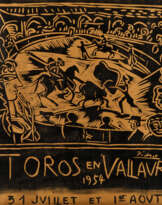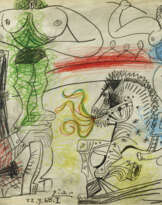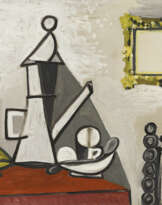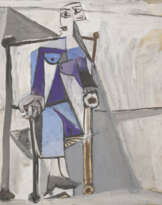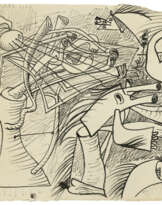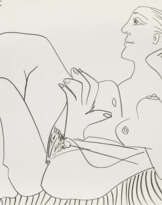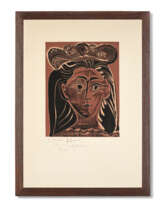ID 1400168
Lot 318 | Pablo Picasso (1881-1973)
Estimate value
€ 320 000 – 520 000
Femme endormie
signé, daté et inscrit '19.8.52. VI Picasso' (en haut à droite)
encre et lavis d'encre sur papier
50.3 x 65.5 cm.
Exécuté le 19 août 1952
signed, dated and inscribed '19.8.52. VI Picasso' (upper right)
ink and wash and ink on paper
19 ¾ x 25 ¾ in.
Executed on 19 August 1952
Provenance
Vente, Mes. Loudmer, Poulain et Cornette de Saint-Cyr, Paris, 29 octobre 1974, lot 36.
Fujikawa Galleries inc., Tokyo (en 1976).
Collection particulière (acquis auprès de celles-ci en 1979).
Vente, Sotheby’s, Londres, 22 juin 2004, lot 490.
E. & R. Cyzer Gallery, Londres.
Collection particulière, Pays-Bas (acquis auprès de celle-ci); vente, Christie's, Paris, 22 octobre 2015, lot 8.
Acquis au cours de cette vente par le propriétaire actuel.
Literature
C. Zervos, Pablo Picasso, Paris, 1985, vol. 15, no. 221 (illustré, pl. 127).
Further details
© Succession Picasso 2025
«Quand un homme regarde une femme endormie, il essaie de comprendre. Quand une femme regarde un homme endormi, elle se demande à quelle sauce elle va le manger.» (Pablo Picasso dans une conversation avec Geneviève Laporte, cité in J. Richardson, A Life of Picasso, New York, 1991, vol. I, p. 317).
Ce commentaire éclairant donne un aperçu de la fascination de Picasso pour les silhouettes endormies, un sujet auquel il reviendra tout au long de sa carrière. Alors que la forme féminine allongée a donné naissance à nombre des tableaux les plus célèbres, de La Vénus d’Urbino du Titien aux Odalisques d’Ingres, Picasso va affiner l’archétype de la femme allongée et y ajouter une catégorie spécifique, la femme endormie. Dans ces œuvres, la passion créatrice de Picasso se nourrit du potentiel physique et émotionnel accru qu’offre son sujet dépourvu de conscience, tout comme Sigmund Freud s’est lancé dans l’exploration du sommeil pour cartographier l’inconscient et sa relation avec nos besoins émotionnels et comportementaux profonds.
Picasso représentera les sensations de séparation et d’érotisme générées par le sommeil de chacune de ses principales compagnes. Dans son autoportrait où il observe Fernande endormie (Contemplation, 1904) la relation entre l’observateur et la dormeuse évoque le rideau émotionnel invisible qui sépare le monde conscient du monde inconscient. Marie-Thérèse apparaît endormie dans de nombreuses œuvres, par exemple dans le chef-d’œuvre gravé de l’artiste Faune dévoilant une dormeuse (Baer 609), où un minotaure soulève un voile pour révéler un corps endormi baigné par la lueur de la lune. Picasso décrira le conflit ressenti par son alter ego dans l’œuvre ainsi : «Il l’étudie, il essaie de lire ses pensées (...) de savoir si elle l’aime parce qu’il est un monstre (…)». (Françoise Gilot, Life with Picasso, Virago Press, 1990, p.42). En 1953, à la fin de sa relation avec Dora Maar, Picasso crée une œuvre remarquable sur le thème de l’observateur, une ombre sombre y est projetée au travers d’une silhouette endormie, une image intrusive et menaçante (L’Ombre sur la femme, 1953). Dans chacune de ces œuvres Picasso intègre un personnage qui le représente lui ou son alter ego, créant une tension dynamique entre les personnages et les différents états de conscience.
Dans d’autres œuvres, la dormeuse est montrée seule au repos, l’accent est alors dans la transformation physique du corps endormi qui s’épanouit voluptueusement. La fascination de Picasso pour sa muse solitaire endormie atteint certainement un sommet en 1932 dans ses portraits de Marie-Thérèse. Dans une série de chef-d’œuvres fantasmés, l’artiste la représente en objet de ses désirs érotiques (Nu au fauteuil noir, 1932) ; il écrit à son propos à l’époque: «Combien je l’aime maintenant qu’elle dort ».
Dans ce dessin à l’encre Picasso emploie plusieurs techniques particulières qui explorent la dimension physique du sommeil. Le modèle ici est allongé sur le dos, les bras relevés entourant sa tête, ce qu’on peut lire comme un geste de protection (et de vulnérabilité donc). Cependant ce geste peut s’interpréter différemment dans le contexte d’une série de dessins d’une jeune fille dansant faits par Picasso immédiatement avant ce dessin. Les bras de la danseuse sont levés au dessus de sa tête et l’artiste peut avoir choisi ce mouvement afin de renforcer le sentiment de libération physique qui accompagne le sommeil. Les contours du corps allongé décrivent un état d’apesanteur, dépourvu de consistance physique. Le spectateur se concentre donc sur le visage à la bouche légèrement entrouverte, aux yeux fermés et aux cheveux retombant en spirales sur les bras. Le modèle endormi échappe au monde physique, laissant le spectateur contempler les distances physiques et émotionnelles qui les séparent.
“When a man watches a woman asleep, he tries to understand. When a woman watches a man asleep she wonders what sauce she is going to eat him with." (Pablo Picasso, in conversation with Genevieve Laporte, cited in J. Richardson, A Life of Picasso, New York, 1991, vol. I, p. 317).
This enlightening comment provides a glimpse into Picasso’s fascination with the sleeping form, a subject which he returned to across the breadth of his career. Whilst the reclining female form had given rise to many of the most celebrated artistic images, from Titian's Venus of Urbino, to Ingre's Odalisques, Picasso would refine the archetype of the reclining woman to include a sub-genre specifically depicting woman asleep. In these works Picasso’s creative passions were fueled by the heightened physical and emotive potential of a subject lost in unconsciousness, in the same way that Sigmund Freud had set out to explore sleep in order to map the unconscious mind and its relationship with our basic emotional and behavioral needs.
Picasso would depict the sensations of separation and eroticism aroused by sleep for each of his principle companions. In his self-portrait watching over the sleeping Fernande (Contemplation, 1904) the relationship of the watcher to the sleeper evokes the invisible emotional curtain that separates the conscious and unconscious worlds. Marie-Thèrese appears in numerous works in sleeping form, for example in the artist’s print masterpiece Faune devoiliant une dormeuse (Baer 609) where a minotaure lifts the veil to reveal her sleeping body bathed in moonlight. Picasso would describe the conflict experienced by his alter ego in this work as: “He’s studying her, trying to read her thoughts…trying to decide whether she loves him because he’s a monster…” (Françoise Gilot, Life with Picasso, Virago Press, 1990, 42). In 1953, towards the end of his relationship with Dora Maar, Picasso created a dramatic example of the theme of the watcher with an intriguing work where a shadow is cast heavily across a sleeping figure, an image of intrusion and portent (L’Ombre sur la femme, 1953). In each of these works Picasso has included himself, or his alter ego in the scene, creating a dynamic tension between the figures and their different states of awareness.
In other works the sleeper is shown alone in her repose, the focus being with the physical transformation of the body at rest into a state of voluptuousness. Picasso’s captivation with the solitary sleeping muse arguably reached a crescendo in 1932 with his portrayals of Marie-Therèse. In a series of fantasy masterpieces the artist depicted her as an object of his erotic desires (fig 3, Nu au fauteuil noir, 1932), about which he wrote at the time: "Combien je l'aime maintenant qu'elle dort (How much I love her now that she's sleeping)."
The present ink drawing sees Picasso employing several specific devices which explore the physicality of sleep. Here, the sleeping model is supine, her arms raised to cradle her head which one identifies with a sense of protectiveness (and therefore vulnerability). However, this gesture has an alternative interpretation in the context of a series of drawings of a dancing girl which Picasso produced immediately prior to this work. The dancer’s arms are thrown above her head, and the artist possibly chose to retain this movement in order to reinforce the sense of physical release which accompanies sleep. The contours surrounding the reclining body here describe a weightless space, deprived of material substance. By consequence, the viewer focusses on her face where her mouth is slightly parted, the eye is tightly closed and the hair falls in spirals across her arms. The sleeping model has escaped the physical world, leaving the viewer to contemplate the distances, whether emotional or physical, which separates us.
| Artist: | Pablo Picasso (1881 - 1973) |
|---|---|
| Medium: | Acrylic glass, Plastic |
| Auction house category: | Paintings, Watercolors, Drawings, Watercolors and drawings |
| Artist: | Pablo Picasso (1881 - 1973) |
|---|---|
| Medium: | Acrylic glass, Plastic |
| Auction house category: | Paintings, Watercolors, Drawings, Watercolors and drawings |
| Address of auction |
CHRISTIE'S 8 King Street, St. James's SW1Y 6QT London United Kingdom | |
|---|---|---|
| Preview |
| |
| Phone | +44 (0)20 7839 9060 | |
| Buyer Premium | see on Website | |
| Conditions of purchase | Conditions of purchase |




